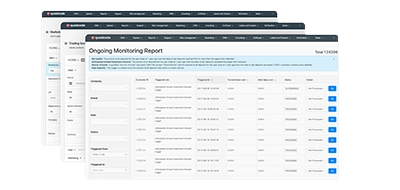Back
Contents
Что такое Облако Ишимоку?

Iva Kalatozishvili
Business Development Manager

Demetris Makrides
Senior Business Development Manager
Облако Ишимоку — это инструмент технического анализа, который трейдеры могут использовать для понимания потенциальной траектории движения рынка, зон поддержки и сопротивления, а также импульса. Этот индикатор технического анализа, разработанный в Японии, объединяет переменные в единый график, предоставляя общую картину рыночных тенденций. Символизируя рыночное равновесие и применимость к различным рынкам и периодам, трейдеры используют Облако Ишимоку для принятия торговых решений.
Элементы облака Ишимоку
Облако Ишимоку состоит из пяти элементов, которые в совокупности дают представление о рыночных тенденциях, импульсе и возможных уровнях поддержки и сопротивления.
Для начала, Линия конверсии Тенкан-сен (Tenkan sen) рассчитывается путём усреднения максимума и минимума за девять периодов. Эта линия играет роль в выявлении краткосрочных трендов. Она может служить ранним сигналом о потенциальной смене тренда. Она даёт трейдерам представление о текущей динамике рынка, отражая недавние ценовые изменения.
Переходим к Базовая линия (Киджун-сен) предлагает иную точку зрения, усредняя максимумы и минимумы за последние 26 периодов. Эта линия важна, поскольку она не только отображает среднесрочные тренды, но и часто служит уровнем поддержки или сопротивления. Трейдеры могут оценить рыночный тренд, ориентируясь на движение Киджун-сен, указывая на нисходящий или боковой тренд.
The Ведущий промежуток А (Сенкоу Спан А), представляющий собой среднее значение Тенкан сен и Киджун сен, отображается на 26 периодов впереди цены.
Этот прогноз отмечает одну сторону облака и помогает оценить уровни поддержки или сопротивления. Он предлагает обзорную точку, позволяющую трейдерам предсказывать, где могут возникнуть значительные ценовые барьеры.
К этому следует добавить Ведущий промежуток B (Сенкоу Спан Б) рассчитывается путём усреднения максимума и минимума за 52 периода и аналогичным образом проецируется на 26 периодов вперёд. Пространство между Сенкоу Спан А и Сенкоу Спан Б заштриховано, образуя «Кумо», или облако. Это облако служит зоной поддержки и сопротивления, а его толщина указывает на силу этих уровней. Более толстое облако указывает на поддержку или сопротивление, а более тонкое — на более слабые уровни.
Наконец, Отстающий диапазон (Chikou Span) представляет цену закрытия. Отображается на графике с отставанием от последнего ценового движения на 26 периодов. Этот запаздывающий сигнал позволяет трейдерам сравнивать уровни цен с прошлыми данными, помогая определить силу и направление трендов. Демонстрируя, как текущие цены согласуются с рыночными движениями, Chikou Span может подтверждать сигналы, получаемые от элементов Облака Ишимоку.
Сочетание этих факторов дает трейдерам глубокое представление о рынке, что делает Облако Ишимоку ценным инструментом для тех, кто ищет информацию о движении цен.
Как работает облако Ишимоку
Облако Ишимоку объединяет эти элементы для отображения рыночных условий. Главной особенностью является само облако, созданное индикаторами Senkou Span A и Senkou Span B, которое отображает уровни поддержки и сопротивления. Когда цена находится выше облака, это указывает на тренд. Облако служит уровнем поддержки. И наоборот, если цена опускается ниже облака, это указывает на тренд, а облако выступает в качестве барьера или сопротивления.
Толщина облака также важна. Более толстое облако указывает на более сильные уровни поддержки или сопротивления, затрудняя движение цен. С другой стороны, более тонкое облако указывает на более слабые уровни. Благодаря корректировкам, происходящим с течением времени, трейдеры могут предвидеть области поддержки и сопротивления, что позволяет им более эффективно планировать входы и выходы из сделок.
Приложение Ichimoku Cloud
Трейдеры используют облако Ишимоку для различных целей, включая идентификацию тренда, определение вероятного разворота, а также определение точек входа и выхода из торговли.
Трейдеры могут быстро определить направление рынка, анализируя положение цены относительно облака. Если цена находится ниже облака, это указывает на нисходящую тенденцию; если выше облака, это указывает на восходящий тренд.
Для рынка облако выполняет функцию динамической зоны поддержки или сопротивления. Когда цена входит в облако, может произойти консолидация или замедление движения. Прорыв тренда выше или ниже облака может означать как его продолжение, так и разворот.
Пересечение линий Tenkan-sen и Kijun-sen генерирует сигналы к покупке или продаже. Эти сигналы можно использовать для продажи или покупки. Например, если цена выше облака, а Tenkan-sen пересекает Kijun-sen, это может быть сильным сигналом к покупке. И наоборот, пересечение линий Tenkan-sen под облаком может указывать на возможную возможность продажи актива.
Преимущества использования облака Ишимоку
Трейдеры часто предпочитают использовать Облако Ишимоку из-за его преимуществ, особенно способности предоставлять комплексное представление о рынке. Одно из его преимуществ заключается в аналитических возможностях. В отличие от индикаторов, которые фокусируются только на одном аспекте поведения рынка, Облако Ишимоку объединяет в одном графике определение тренда, оценку импульса и уровни поддержки/сопротивления. Это позволяет трейдерам понимать динамику рынка, не прибегая к индикаторам, которые могли бы затруднить анализ.
Ещё одним важным преимуществом является визуальная наглядность и простота понимания структуры облака. Уникальный внешний вид облака позволяет быстро и наглядно интерпретировать рыночные условия, помогая трейдерам быстро определить, находится ли рынок в тренде или консолидируется. Более того, благодаря цветовой кодировке, обозначающей зоны поддержки и сопротивления, оно становится интуитивно понятным, позволяя трейдерам принимать более обоснованные решения.
Универсальность облака Ишимоку является ещё одним фактором. Оно является отличным инструментом для различных торговых стратегий, поскольку совместимо с широким спектром рынков и таймфреймов, включая Форекс, сырьевые товары и акции. Облако Ишимоку зарекомендовало себя как ценный рыночный инструмент, независимо от того, специализируются ли трейдеры на краткосрочном инвестировании, внутридневной торговле или на том и другом. Прогнозируя уровни поддержки и сопротивления, это облако помогает трейдерам предвидеть движение цен до того, как оно произойдет. Этот предсказательный элемент даёт трейдерам преимущество перед техническими индикаторами, которые полагаются преимущественно на исторические данные. С помощью облака Ишимоку трейдеры могут получать информацию о рыночных тенденциях, что позволяет им осуществлять стратегическое торговое планирование.
Недостатки облака Ишимоку
Хотя облако Ишимоку — универсальный инструмент, оно не лишено ограничений. Чтобы совершать обоснованные сделки, трейдерам, полагающимся на этот индикатор, необходимо знать об этих ограничениях.
Облако Ишимоку может быть сложным, что для некоторых является серьёзным препятствием при его использовании. Индикатор включает в себя линии и затенённую область, обычно называемую облаком, что может представлять сложность для новичков в интерпретации.
Задержка сигнала Облака Ишимоку может привести к потере возможностей на волатильных рынках, где цены часто колеблются. Трейдеры могут обнаружить, что к моменту подтверждения сигнала цена уже значительно изменилась.
В ситуациях, когда направление рынка неясно, индикатор может давать ложные сигналы, что потенциально может привести к убыткам. Структура облака, хорошо работающая на трендовых рынках, может не обеспечивать уровней поддержки или сопротивления на рынках, где цены колеблются в узком диапазоне.
Более того, стандартные настройки Облака Ишимоку (9, 26, 52) изначально были разработаны для фондового рынка Японии, где раньше действовала шестидневная торговая неделя. На современных рынках, где стандартной практикой является пятидневная торговая неделя, эти настройки могут быть не всегда идеальными. Тот факт, что трейдерам часто приходится корректировать настройки в соответствии с различными рынками и периодами, ещё больше усложняет использование индикатора.
Кроме того, не все активы и торговые стратегии будут работать с облаком Ишимоку, несмотря на его гибкость и применимость к различным рынкам. Например, надёжность сигналов, предоставляемых облаком, может быть снижена на рынках с низкой ликвидностью или высокой волатильностью из-за снижения точности прогнозов облака. Трейдеры, которых больше интересует высокочастотная или краткосрочная торговля, могут посчитать эту индикацию слишком сложной или медленной для своих нужд.
Распространенные ошибки при использовании облака Ишимоку
Несмотря на эффективность облака Ишимоку, трейдеры часто ошибаются в интерпретации сигналов, что приводит к неверным торговым решениям. Одна из распространённых ошибок — фиксация на отдельных компонентах облака вместо рассмотрения его общей структуры. Например, некоторые трейдеры могут чрезмерно полагаться на пересечения линий Тенкан-сен и Киджун-сен, не принимая во внимание контекст, предоставляемый самим облаком или линией Чикоу-спан. Это упущение может привести к открытию торговых позиций без понимания текущей рыночной ситуации.
Другая распространённая ошибка — игнорирование толщины облака. Трейдеры, упускающие этот аспект, могут преждевременно входить в сделки, не осознавая, что значительные уровни сопротивления или поддержки могут помешать движению цены, прежде чем она совпадёт с их ожиданиями.
Трейдеры также иногда совершают ошибку, применяя настройки по умолчанию для Облака Ишимоку на всех рынках и во всех таймфреймах.
Настройки по умолчанию были созданы с учётом специфики рыночной среды. Они могут не подходить для всех торговых ситуаций. Несоблюдение этих настроек в соответствии с меняющимися рыночными условиями или таймфреймами может привести к появлению сигналов и неблагоприятным торговым решениям.
Более того, ещё одной распространённой ошибкой является использование только Облака Ишимоку без проверки сигналов другими индикаторами или методами анализа. Хотя Облако Ишимоку является достаточно полным инструментом, оно работает эффективнее в сочетании с такими инструментами, как индикаторы объёма или фундаментальный анализ. Такой подход помогает предотвращать появление сигналов и даёт комплексное представление о рынке.
Настройка облака Ишимоку
Облако Ишимоку само по себе является очень мощным индикатором. Однако оно может быть ещё более эффективным при правильной настройке под конкретные рынки и таймфреймы. Как упоминалось ранее, изначально этот индикатор применялся на японском фондовом рынке, работающем по шестидневной торговой неделе. Поэтому его необходимо адаптировать к текущим торговым условиям рынка.
При использовании облака Ишимоку на рынке Форекс трейдеры часто устанавливают более короткие периоды, например, 7, 22 и 44 (не финансовые рекомендации). Изменение этого параметра позволяет сигналам лучше отражать круглосуточную работу рынка Форекс. При использовании облака Ишимоку для торговли сырьевыми товарами или акциями также необходимо вносить коррективы. Эти рынки часто реагируют на внешние факторы и факторы, такие как спрос и предложение, погодные явления или геополитическая напряженность. Для обеспечения надежности сигналов необходимо настроить параметры облака для определения и отслеживания текущих рыночных тенденций.
Облако Ишимоку также можно настраивать для разных таймфреймов в зависимости от специфики торговли. Например, дейтрейдеру или скальперу, а также свинг-трейдеру потребуется соответствующим образом настроить таймфреймы.
Краткосрочные трейдеры, такие как дейтрейдеры или скальперы, обычно используют 5- и 15-минутные графики Облака Ишимоку для отслеживания трендов, оценки динамики рынка и определения точек входа и выхода. На более коротких таймфреймах Облако Ишимоку способно быстрее реагировать и адаптироваться к колебаниям цен.
Трейдеры, предпочитающие торговлю на более длительных таймфреймах, например, свинг-трейдеры или инвесторы, обычно используют дневные и недельные графики в Облаке. Поскольку их не беспокоит краткосрочная волатильность актива, более крупные таймфреймы сглаживают и устраняют краткосрочный шум, выделяя значимые тренды, а также основные уровни поддержки и сопротивления, которые играют важнейшую роль в долгосрочной торговле.
Заключение
Облако Ишимоку — это универсальный инструмент, дающий трейдерам представление о рынке. Объединяя данные в один индикатор, он рисует подробную картину трендов, импульса и уровней поддержки/сопротивления. Независимо от того, используется ли оно для определения тренда, определения разворота или планирования торговли, включение облака Ишимоку в ваш торговый арсенал имеет решающее значение. Освоение этого индикатора может значительно повысить вашу способность уверенно и точно ориентироваться на рынке.
Обновлено:
19 декабря 2024 г.




